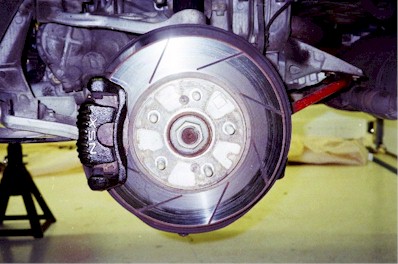
Changing Rear Brake Pads

| Time, Total Time, Cost, First-Time Cost | 50min, 1h25min, |
| Number of Persons | 1 |
| Difficulty level | 5 |
| Tools | Torque wrench, 10mm, 12mm,14mm socket, wire, high-temp grease, emery cloth, brake clean, needle-nose pliers |
| Special Tools | Rear Brake Tool |
| Special Parts | Pads |
| Service Manual Pages | 19-17-18 |
| Service Interval | Pad thickness less than 1.7mm |
| Prerequisite | Jack (20min), Rear Wheels (15min) |
| THE FAQ at www.nsxprime.com |
Determining Pad Wear
First, let's make sure we really need to change our pads. The
service manual suggests changing the pads when they have less than 1.7mm of
material left. For reference, the backing plate is about 6mm wide, so
wait until the pad material is about 1/3 the size of the backing plate, then
replace the pads. If you are taking the car to the track, make sure you
have enough pad material to last the day or plan on replacing the pads between
sessions. Pads with wear indicators, like the OEM pads, will squeak or chirp when they
need replacing; this noise is the metal "sensor", which is part of
the pad, rubbing on the rotor. This noise will usually disappear when the
brakes are engaged. Pads without wear indicators (most track pads) will
grind and spark when they are worn to their backing plates <g>. We can inspect
our pads by either removing the
wheel or looking between the wheel spokes and through the inspection ports in the
caliper body (picture below right).
Check out the brake overhaul section for some good pictures of our front calipers!
Above: these OEM pads have 8.8mm left.
Procedure
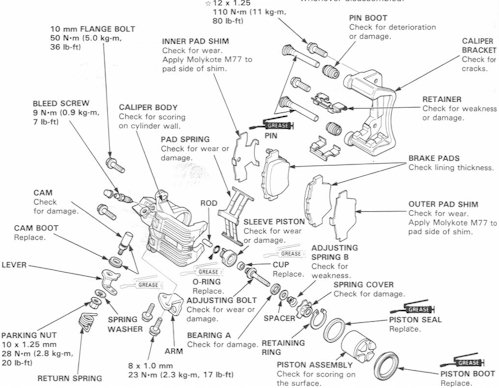

1. Prepare Tools and Pads. We will need 10mm, 12mm and 14mm sockets, a ratchet, the special brake tool, needle nose pliers, a torque wrench, brake lube and brake clean. A magnetic parts tray will keep us from losing small parts.
2. Jack up the car and remove the rear wheels.
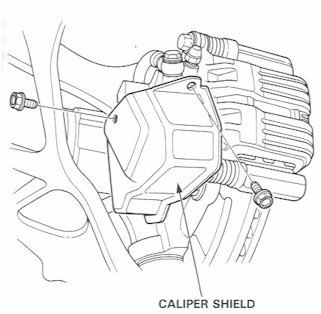
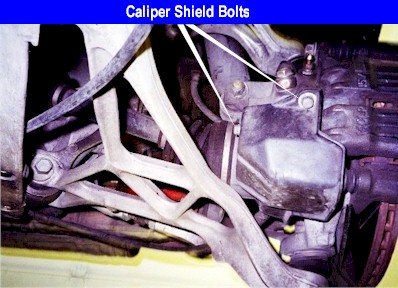
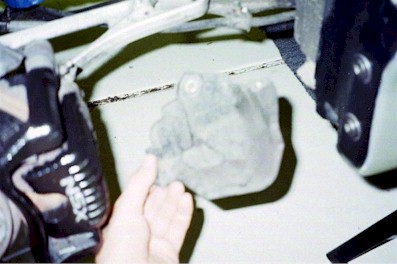
3. Remove the 2 (10mm) caliper shield bolts and remove the shield.
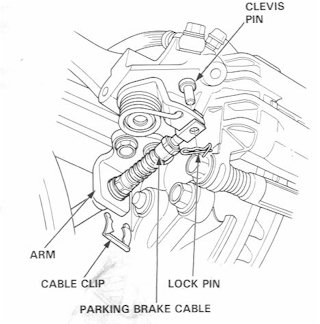
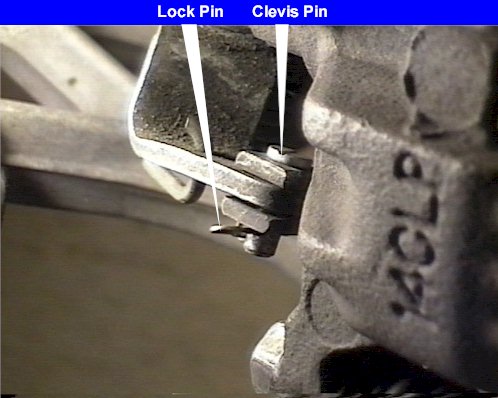
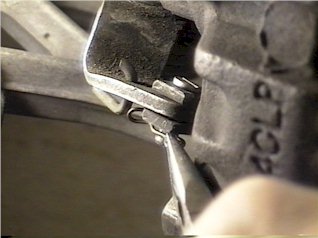
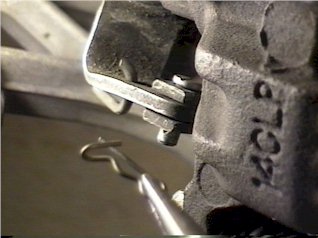
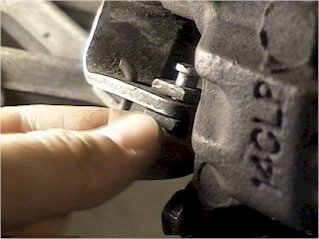
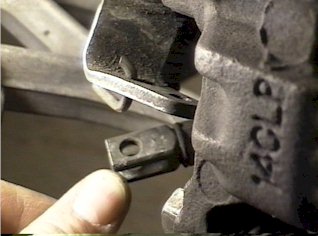
4. Release the parking brake. Use the needle-nose pliers to remove parking brake lock pin and clevis pin and move the parking brake cable out of the way.
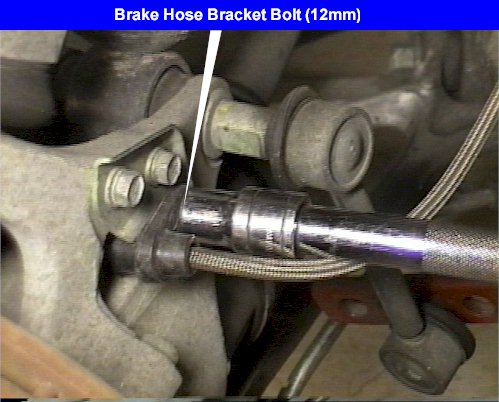
5. (Optional) Remove the brake hose bracket (12mm). This step is optional because the caliper body can come off without stressing the brake hose. It's probably a good idea to do this step your first few times through just to give the brake hose a little more freedom to move around.
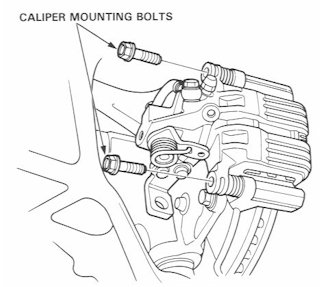
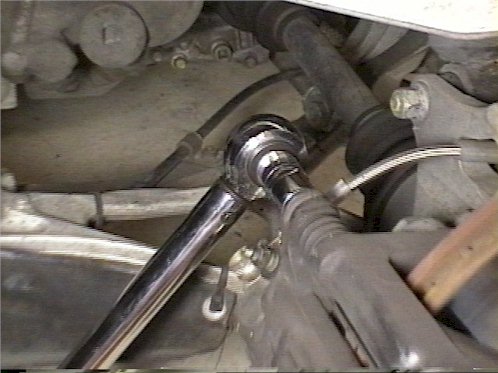
6. Remove the two caliper bolts, use the 14mm socket and torque wrench to break them free. Finish removing them with your fingers or the ratchet.
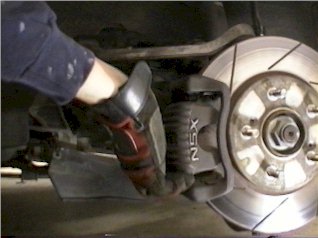
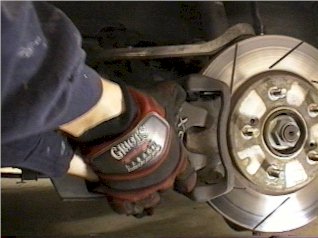
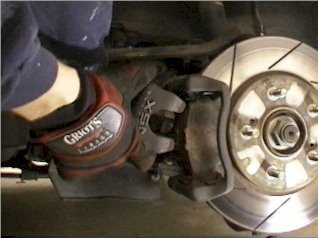
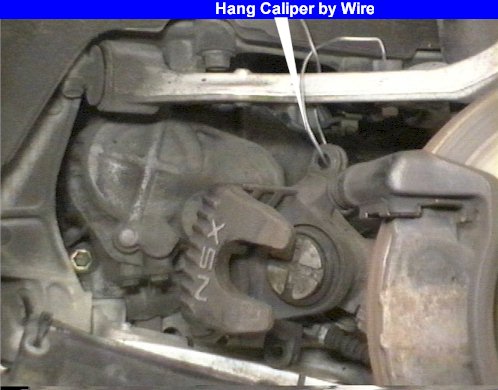
7. Remove the caliper body and support it with wire so it's not hanging from the brake hose. Removing the caliper can be a little tricky and may require a little bit of force if it's really crusted on. Watch the brake hose carefully to make sure you're not putting too much stress on it when wiggling the caliper body free. Grasp the lower portion of the body and wiggle it up and down a little as you pull outward. Pull outward to break it free. Have the wire handy to support the caliper. I run the wire through the upper caliper bolt hole and secure it to the upper control arm. You can also temporarily place (hook) the caliper on the control arm if you forget where you put your wire <g>.
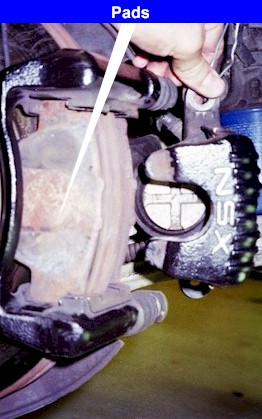
8. Remove your old pads and shims. Not all pads come with shims so don't be concerned if you don't have these. The shims are supposed to reduce break squeal, they come new with OEM brakes. Unless they're really crusted on, the pads should come out by hand, if not, use a large flat-blade screwdriver to gently pry them out.

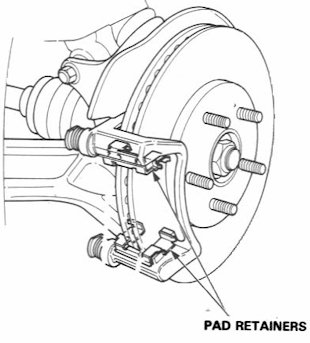
9. Remove the two caliper pins (above), clean them off and grease them with high-temp grease then reinstall. The pins pull out of the rubber pin boots. When reinstalling, make sure the two flat surfaces of the head are horizontal. Clean the upper and lower pad retainers with brake cleaner and /or your emery cloth. Note: WD-40 and other similar lubricants/cleaners should be avoided when working with the brakes.
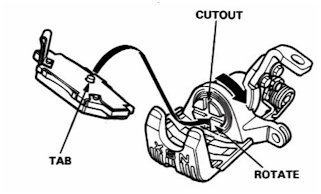

10. Install your new pads, the one with the tab will go on the inside. The OEM pad comes with two shims, install the one with the hole for the tab on the inside pad. The OEM pads also come with Molykote M77 in a tube, spread this on both sides of each shim.
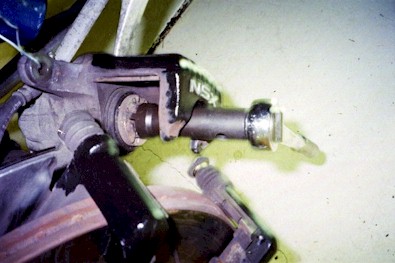
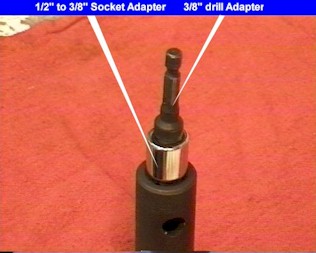
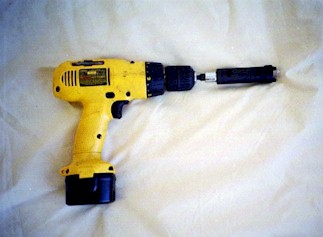
11. We'll assume your new pads are thicker than your old ones so you will need to retract the caliper piston into the caliper body before installation. Use the special brake tool to screw the piston in a clockwise direction. It may take several (20 or so) revolutions until it will have enough clearance to be installed. Try to line up the cutout in the piston with the tab on the brake pad. This can be tricky. If you have a cordless drill, you can save some time and agony by using a couple of adapters and let the drill do the work. Check your brake reservoir as you turn the piston. If you reservoir has been filled since your last brake change, it may overflow. The excess fluid can be extracted with a turkey baster (see bleeding the brakes).
12. Remove the wire holding the caliper body and reinstall the caliper over the pads and onto the caliper bracket. The flat sides of the caliper pins will have to seat perfectly into the caliper body. If the caliper body does not seat perfectly, re-check to make sure the tab on the inside pad is positioned in the cut-out groove of the piston.
13. Install the two caliper bolts and torque them to 36 lb-ft (14mm socket). To avoid striping, these should be started by hand. get them both hand tight before torquing them. 36 lb-ft doesn't seem like much so be careful no to over-torque. If the caliper is not seated properly these are difficult to start. If this is the case then recheck the position of the caliper on the caliper bracket and make sure the pins are seated correctly.
14. Reinstall the parking brake cable by inserting the pin through the lever and the cable. The needle-nose pliers may be required to position the pin just right. Use the needle-nose pliers to install the lock pin.
15. Reinstalling the caliper shield can be frustrating because getting the orientation just right seems like a puzzle. Hold the shield in your left hand, when orientated properly, underside screw hole will be just above your thumb and the upper hole will be directly across from you. OK, I'll take a picture next time I have a chance <g>.
16. Install the brake hose bracket bolt 16 lb-ft (12mm), if applicable (see step 5).
17. Reengage the parking brake from the cockpit.
IMPORTANT STEP
18. Before lowering the car, pump the brake pedal several times
until you get a firm pedal. Remember turning the pistons (step #11),
this will turn them back out until they hit the pads.
19. Reinstall the wheels, lower the car and torque the lug nuts.
20. Check you brake fluid level in the reservoir and empty/fill as necessary so the fluid is at the MAX line.
21. Bed in your new pads!